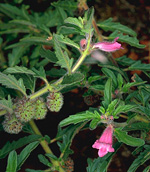 |
This small family occurs in the drier parts of the Old and New World tropics, particularly in Africa and Central America. A few native species of Josephinia occur in Australia; other species are introduced weeds. They are found in open, dry habitats across northern Australia extending to the drier parts of the temperate states.
Characteristic features of the family Pedaliaceae in Australia include: - annual or perennial herbs, usually sticky-pubescent and sometimes strongly aromatic
- leaves opposite or alternate, simple
- flowers small or showy, bisexual, solitary in upper axils or forming terminal racemes
- calyx of 5 free sepals; corolla zygomorphic with 5 spreading lobes
- stamens 4 (or with a fifth, small sterile one), in 2 pairs
- ovary superior, developing into a capsule which in some genera is woody and sharply horned, or a small burr
Description
Annual or biennial terrestrial herbs. Stem internodes ±terete, distinctly angled or winged. Internal secretions not obvious, or mucilaginous. Plants glabrous, or with simple or dendritic, glandular or non-glandular, uniseriate or multiseriate hairs. Leaves alternate and spiral, or opposite, all or mostly cauline, petiolate. Stipules absent. Lamina simple or ternate, symmetric, pinnatifid or pinnatisect or bipinnatifid or tripinnatifid, etc, ovate, lanceolate, oblong or orbicular; base cuneate, attenuate, rounded or cordate; margin entire, dentate, serrate or sinuate; margins ±flat or undulate; venation pinnate, or palmate, with the midrib conspicuous, and the tertiary venation reticulate or absent; surfaces punctate or not punctate; herbaceous; distinctive odour absent or aromatic. All the flowers bisexual. Inflorescences terminal or axillary, consisting of racemes or solitary flowers. Bracts absent or present. Pollination by insects. Flowers odourless or fragrant, stalked. Floral disc absent or present; nectaries present on the disc. Perianth of 2 dissimilar whorls, imbricate in bud. Calyx regular or irregular; segments free or fused, with 5 sepals or lobes; calyx bell-shaped, herbaceous or leathery. Corolla irregular; segments fused, with 5 lobes, alternating with the sepals or lobes; corolla bell-shaped or funnel-shaped, 2-lipped, white, cream, yellow, pink, purple, magenta or violet, blue, without contrasting markings, or streaked, spotted, etc, membranous; lobes more or less entire. Fertile stamens 2 or 4, opposite to the sepals or lobes, free or fused with the corolla, free or fused with the ovary or style, distinct from each other or united by their anthers. Staminodes absent or present. Anthers dorsifixed, versatile or not versatile; opening inwards by longitudinal slits, 2-celled; appendages absent or apical. Ovary superior and sessile. Carpels 2 or ?4, fused; ovary with (1–) 2, or apparently 4 or 8 locules. Style single, branched above, terminal. Ovules one to numerous per locule, stalked; placentation parietal or axile. Fruit a dry dehiscent loculicidal capsule, or an indehiscent nut; the perianth on the maturing fruit deciduous, or dry and persistent. Disseminule macro-surface with stiff, straight, sharp, unbarbed hairs, bristles or spines or hooked spines, beak or awns; micro-surface ±smooth or reticulate, alveolate or foveate, or rugose, grey or black, dull. Seeds 1–numerous per fruit. Aril absent. Cotyledons 2. Embryo straight
(Note: this description has been generated from the coded data compiled for the key. Any errors in the key data will be reflected in the descriptions.)
A treatment of the family Pedaliaceae has not yet been published in the Flora of Australia. It will appear in Volume 33.
Australian genera of Pedaliaceae (as recognised for the Flora of Australia)
* = all species introduced
*Ibicella
Josephinia
*Martynia
*Proboscidea
*Sesamum

|
  |

Josephinia eugeniae (flowers and fruit)
Photo: M.Fagg © M.Fagg

Josephinia grandiflora (flowers)
Photo: D.Jones © D.Jones
|

| |